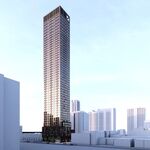Let's address the points now, shall we?
Having LRTs in dedicated lanes down the center of streets forces riders to cross busy streets to access the vehicles, slows down transit by making LRTs stop at every light, and takes away scarce traffic lanes for vehicles.
First - riders, depending on their access patterns, could very well have to cross busy streets to access transit even if it is a subway line; properly implemented LRT lines will have signal priority that would minimize stopping at intersections - which they would have to do anyways for on/off loading purposes depending on the location of the stop; and under the current plan no traffic lanes are sacrificed for the proposed lines.
Furthermore, Toronto’s warm summers and ice cold winters means above ground tracks have to be torn up and replaced frequently at enormous expense and inconvenience to all concerned (ask College Street and Queen Street denizens who have endured this three times in just the last decade).
How many times have the Spadina "LRT" been torn up and replaced since 95?
Most cities in the US and Europe with LRTs (except Minneapolis which has one very small LRT) have much more temperate climate than us.
The Central Corridor under construction in Minneapolis is 18km; Denver has 63km of light rail lines; Calgary C-Train has 48km. All have climates that are harsh, if not harsher than ours.
Transit City supporters claim world class cities often have mixed systems of subways and LRTs. True, but the devil is always in the details, and these LRT fans need to look at the size of the cities and exact proportion of subways and LRTs. Smaller cities with populations of approximately a million (like Zurich and Charlotte), have big LRT systems and small subways, while larger dense burghs like London and Paris have huge subways and minimal LRT.
Our metropolitan region (5 million plus) is much closer in size and density to Madrid and Paris than Zurich. And Paris has 215 km of subway and only 30 km of streetcars. Toronto’s puny subway is 70 km long and highly inadequate for the size and density of our region. We need to have a minimally adequate subway network before we even think of LRT, and any scarce dollars should be directed to subways.
And where are the dense areas in London and Paris, what densities are we talking about relative to where are the subways located, and what's the linkage between said lines with the suburban hinterland, and their prioritization of the construction of said lines?
Replacing bus service with LRT will merely replace one transfer with another. The Sheppherd stub subway is under used because it ends too early; extending it to Scarborough Town Center will certainly boost ridership, as well as eliminate that ridiculous transfer at Fairview.
And yet there is no discussion on converting an underused stub subway into LRT in order to eliminate that transfer.
The Toronto Star recently published statistics showing that employment levels near Scarborough Centre and North York Centre have not been as high as expected, so a full subway linking those two nodes would not generate much ridership.
This shows that the Star has no clue as to how transit works. A subway will not be used only to carry employees to town centers; huge shopping malls and massive residential complexes also exist at such centers. People use subways not just to get to work, but also for shopping, entertainment, and other needs.
Suggesting that a subway linking two centers is useless because employment there is lower than expected is similar to claiming that building the Yonge and University subway lines was unnecessary because employment in Toronto’s financial core dipped during the recession.
Note the equating of "transit" with "subways" - is subway the only valid way to serve that need? And is the said individual comparing the ridership of Yonge line to downtown to even the most optimistic projections for Sheppard?
Splitting the savings between a Sheppherd and Finch LRT is the worst possible solution. It will satisfy neither Etobicoke riders along Finch West nor Scarborough riders east of the DVP.
How does Finch LRT not satisfy Etobicoke riders, who had to contend with a) buses and b) nothing else for the forseeable future?
Mayor Ford is quite right: any money available should be devoted to subway expansion and not squandered on LRT. Areas like Finch West which clamour for better solutions than buses would do better to wait for a real solution (subways) in the future than an LRT which won’t do the job.
Numbers please.
If billions of dollars are spent today on an LRT for Finch, then people in North Etobicoke can kiss goodbye to any hope for future subway service. The best way to tell these people that they are worthless is to permanently doom their future subway aspirations in return for a quick band aid which barely improves their current service.
As if Bloor and Yonge lines aren't streetcars (not even LRT) lines to begin with. Where the need arises, transportation infrastructure will be upgraded.
AoD




